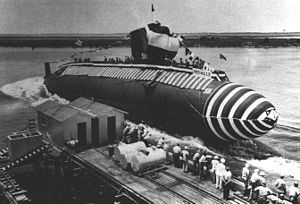Barbel-class submarine

The launch of USS Blueback (SS-581) in 1959
|
|
| Class overview | |
|---|---|
| Name: | Barbel class |
| Builders: | |
| Preceded by: | Darter class |
| Built: | 1956 – 1959 |
| In commission: | 1959 – 1990 |
| Completed: | 3 |
| Retired: | 3 |
| Preserved: | 1 |
| General characteristics | |
| Type: | Attack submarine |
| Displacement: | |
| Length: | 219 ft 2 in (66.80 m) overall |
| Beam: | 29 ft (8.8 m) |
| Draft: | 29 ft (8.8 m) max |
| Propulsion: |
|
| Speed: |
|
| Range: | 14,000 nautical miles (26,000 km) surfaced at 10 knots (19 km/h) |
| Endurance: |
|
| Test depth: | 700 ft (210 m) |
| Complement: | 8 officers, 69 men |
| Sensors and processing systems: |
|
| Armament: | 6 × 21 in (533 mm)bow torpedo tubes, 22 torpedoes |
The Barbel-class submarines (affectionately known in the United States Navy's submarine force as the 'B-Girls'), the last diesel-electric propelled attack submarines built by the United States Navy, incorporated numerous, radical engineering improvements over previous classes. They were the first production warships built with the teardrop-shape hull first tested on the experimental USS Albacore (AGSS-569), and the first to combine the control room, attack center, and conning tower in the same space in the hull. This class of submarine became part of the United States Navy's fleet in 1959 and was taken out of service 1988–1990, leaving the Navy with an entirely nuclear-powered submarine fleet.
The Barbel class' design is considered to be very effective. The Zwaardvis-class submarine of the Netherlands and the Hai Lung-class submarine of the Republic of China (built and sold by the Netherlands) were developments of the Barbel class design. The Japanese Uzushio class and its successors were also influenced by the Barbel class.
The class overall was a somewhat smaller diesel-powered version of the Skipjack-class nuclear submarines, the first of which entered service only three months after Barbel, having been laid down only 11 days later. Several features of the experimental Albacore were used in the Barbel-class design, most obviously the fully streamlined "teardrop" hull. Albacore's single-shaft configuration, necessary to minimize drag and thus maximize speed, was also adopted for the Barbels, Skipjacks, and all subsequent US nuclear submarines. This was a matter of considerable debate and analysis within the Navy, as two shafts offered redundancy and improved maneuverability. For the first time, the Barbels also combined the functions of conning tower, attack center, and control room in the same space, another feature adopted for all subsequent US submarines. This was facilitated by the adoption of "push-button" ballast control, another feature of Albacore. Previous designs had routed the trim system piping through the control room, where the valves were manually operated. The "push-button" system used hydraulic operators on each valve, remotely electrically operated (actually via toggle switches) from the control room. This greatly conserved control room space and reduced the time required to conduct trim operations. The overall layout made coordination of the weapons and ship control systems easier during combat operations.
...
Wikipedia
